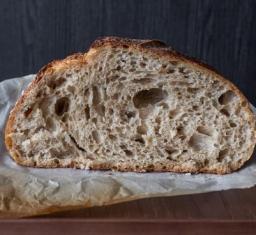
Last weekend I took another stab at the Sourdough English muffins, going with some of the modifications that I suggested in my previous post. Here is my recipe for this batch with the changed ingredients from Nancy Silverton's original recipe in boldface:
SPONGE:
18 oz White Starter
2 cups plain soy milk
7 oz unbleached white bread flour (high extraction - 14% protein) (I used 1 oz less)
3.5 oz dark rye flour
DOUGH:
Sponge
10 oz warm water (85 degrees)
0.3 oz of SAF instant yeast
1/4 cup oat bran
1/4 cup wheat germ
1/4 cup flax seeds
1/4 cup rye flakes
2 tbs raw sunflower seeds
2 tbs raw pepitas
7 oz unbleached white bread flour (high extraction - 14% protein)
1/4 cup (minus a smidge) honey
1/4 cup vegetable oil
1 3/4 tbs kosher salt
Cake flour for dusting
Semolina flour for dusting
This time, I was able to make the muffins over the course of one day as the original recipe calls for. The sponge fermented for about 2 hours before I made the final dough which in turn rose for another hour and a half.
I decided this time that I needed more strength for the parchment paper rings and so I cut the pieces of parchment twice as tall and then folded in half. While seeming like a good idea, it ended up being more difficult to fill the rings since the dough got caught between the folded layers on a few of the muffins and the strength of the rings was no greater. Besides, I cost me double the amount of parchment paper.
The use of the cake flour for dusting the board became a real pain since the dough was more hydrated in this version than the last. Most of it clumped up and took some effort to brush off. In the end, using no flour at all and keeping my hands slightly damp to help handle the dough would have worked much better.
The muffins rose in the rings for about an hour and then I dusted them with semolina and tossed them in the oven.
I waited until the next day before tearing one open and they were much tastier than the last batch. The sweetness of the honey was much mellower than the agave nectar and the wheat germ and rye flakes added even more heartiness in flavor and texture.

My wife and I have been enjoying them as the base for fried egg sandwiches: toased muffin, 1 fried egg, 2 slices of facon (veggie bacon), a think spread of garlic herbed queso fresco from Shepard's Way and a smear of dijon mustard.








